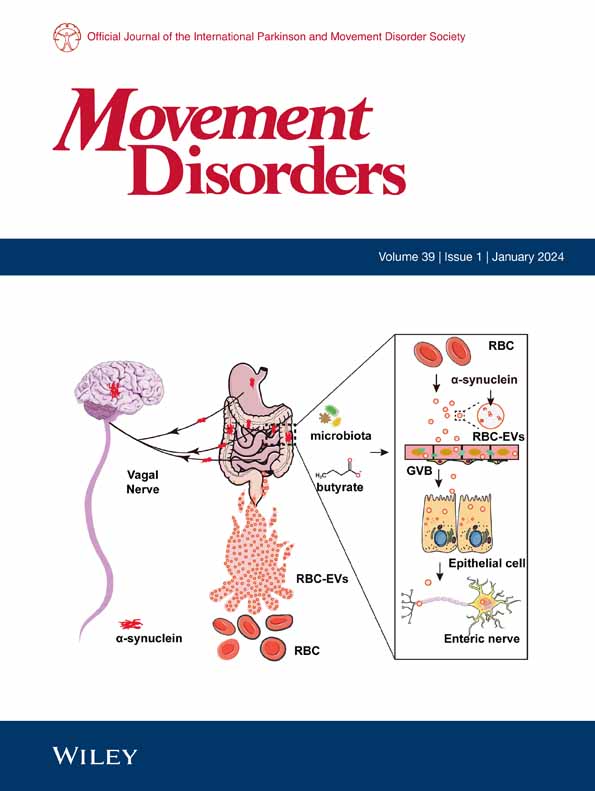Peripheral Mononuclear Cell Mitochondrial Function Associates with T-Cell Cytokines in Parkinson's Disease.
IF 7.4
1区 医学
Q1 CLINICAL NEUROLOGY
引用次数: 0
Abstract
BACKGROUND Parkinson's disease (PD) is the most common neurodegenerative movement disorder and one of the world's fastest-growing neurological diseases. Although the exact causes of PD are unknown, mitochondrial dysfunction and inflammation may have significant roles in disease progression. As well as being prevalent in the brain, there is also evidence that peripheral mitochondrial dysfunction and inflammation occur in PD. However, if/how peripheral mitochondrial dysfunction and inflammation are linked is still unclear. OBJECTIVES This study aimed to determine the extent that mitochondrial dysfunction in peripheral immune cells is associated with inflammation in PD. METHODS The study comprised of 35 controls and 35 PD patients that were age and sex matched. Flow cytometry was used to assess mitochondrial content and superoxide production in mononuclear cells, in the presence and absence of the mitochondrial stressor antimycin A. Serum inflammatory cytokines were measured by ELISA. RESULTS Superoxide levels were significantly increased in PD patient mononuclear cells at baseline, and PD mononuclear cells had an impaired response to antimycin A. Immune cell superoxide levels correlated with serum cytokines associated with T-cell responses, namely interleukin (IL) IL-12, interferon-γ, and IL-17A. CONCLUSIONS Results show that mitochondrial dysfunction is prevalent in PD immune cells and may contribute to an inflammatory phenotype. © 2025 The Author(s). Movement Disorders published by Wiley Periodicals LLC on behalf of International Parkinson and Movement Disorder Society.帕金森病外周血单核细胞线粒体功能与t细胞因子相关
帕金森病(PD)是最常见的神经退行性运动障碍,也是世界上增长最快的神经系统疾病之一。虽然帕金森病的确切病因尚不清楚,但线粒体功能障碍和炎症可能在疾病进展中起重要作用。除了在大脑中普遍存在外,也有证据表明周围线粒体功能障碍和炎症发生在PD中。然而,外周线粒体功能障碍与炎症之间是否/如何联系尚不清楚。目的本研究旨在确定外周免疫细胞线粒体功能障碍与帕金森病炎症的关联程度。方法选取年龄、性别相匹配的35例PD患者和35例对照组。在线粒体应激源抗霉素a存在和不存在的情况下,流式细胞术评估单核细胞线粒体含量和超氧化物的产生。结果PD患者单核细胞超氧化物水平在基线时显著升高,PD单核细胞对抗霉素a的反应受损。免疫细胞超氧化物水平与t细胞反应相关的血清细胞因子,即白细胞介素(IL) IL-12、干扰素-γ和IL- 17a相关。结论线粒体功能障碍在帕金森病免疫细胞中普遍存在,并可能导致炎症表型。©2025作者。Wiley期刊有限责任公司代表国际帕金森和运动障碍学会出版的《运动障碍》。
本文章由计算机程序翻译,如有差异,请以英文原文为准。
求助全文
约1分钟内获得全文
求助全文
来源期刊

Movement Disorders
医学-临床神经学
CiteScore
13.30
自引率
8.10%
发文量
371
审稿时长
12 months
期刊介绍:
Movement Disorders publishes a variety of content types including Reviews, Viewpoints, Full Length Articles, Historical Reports, Brief Reports, and Letters. The journal considers original manuscripts on topics related to the diagnosis, therapeutics, pharmacology, biochemistry, physiology, etiology, genetics, and epidemiology of movement disorders. Appropriate topics include Parkinsonism, Chorea, Tremors, Dystonia, Myoclonus, Tics, Tardive Dyskinesia, Spasticity, and Ataxia.
 求助内容:
求助内容: 应助结果提醒方式:
应助结果提醒方式:


